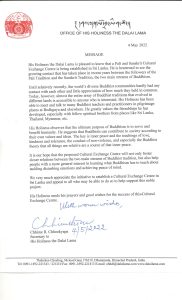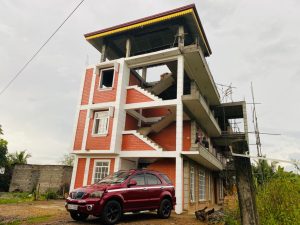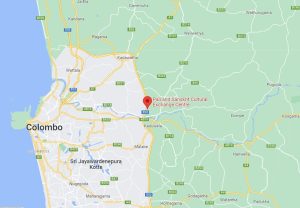PALI AND SANSKRIT CULTURAL EXCHANGE CENTRE
A Historic Initiative to Strengthen Buddhist Brotherhood which Leads to Understanding, Awareness and a World of Compassion
Theravāda, the school of the Elders, began to take shape in India in around 250 BC. It is considered the most orthodox form of Buddhism and has followers mainly in Southeast Asia, especially in Sri Lanka, Thailand, Myanmar, Cambodia and India. Mahāyāna, the Great Vehicle, slowly came into being around the 1st century B.C., with contemporary followers mainly in Tibet, India, China, Japan, Vietnam and Korea. Theravada canon is written in Pāli while the Mahayana literature is in Sanskrit. Therefore, it is evident that the Buddha’s teachings have been translated from the two major languages, Sanskrit and ‘Pāli’. Orally transmitted Theravada Buddhism spread from India to Sri Lanka was recorded in ‘Tripitaka’ in ‘Pāli’ language. The Sarvāstivādin Piṭakas were mostly transmitted in Sanskrit and many Mahāyāna sūtras such as the ‘Prajñāpāramitā sūtra’ were composed in different registers of Sanskrit. The Buddhist use of classical Sanskrit for literary purposes possibly began with Asvaghoṣa [100 CE], author of the ‘Buddhacarita’ and one of the earliest Sanskrit dramatists. Buddhist thinkers like Nāgārjuna, Āryadeva, Asaṅga, Vasubandhu, Dignāga, Sthiramati, Dharmakīrti, Bhāviveka, Candrakīrti, etc., also wrote in Sanskrit.
Recording the Buddha’s teachings in different languages doesn’t matter but the division. The division has been created slight differences in theoretical facts and ‘vinaya’ creating certain contradictory arguments. On account of the gap which has been created, a responsibility lies with the Buddhists to go out of the way to minimize it.
Considering the Sri Lankan context, even though Sri Lanka apprehends the orthodox tradition ‘Staviravāda’ or later on known as ‘Theravāda’, introduced by Arahant Mahinda Thero during the period of king Devanampiyatissa in the 3rd Century BCE, the history reveals, Sri Lankan Buddhism, too, had welcomed certain transformations, while still considering the central doctrine as the nucleus. From 8th century CE to 12th century CE Sri Lankan Buddhism was open to Mahayana. Abhayagiri Theravādins maintained close relations with Indian Buddhists over the centuries, adopting many of the latter’s teachings including many Mahāyāna elements, whereas Jetavana Theravādins adopted Mahāyāna to a lesser extent. It is known that in the 8th century, both Mahāyāna and the esoteric Vajrayāna form of Buddhism were being practised in Sri Lanka. Abhayagiri remained an influential center for the study of Theravāda, Mahāyāna and Vajrayāna thought from the reign of Gajabahu I until the 12th century. At the same time, various important Buddhist scholars were working in both Sanskrit and Pāli. These include ‘Upatissa’, who wrote the ‘Vimuttimagga’, Kavicakravarti Ananda, authored the ‘Saddhammopåyana’, Aryadeva, Aryasura, and the tantric masters Jayabhadra, and Candramåli all from India.
Based on the above historical facts one can conclude that Theravada Buddhism prevailing in Sri Lanka has been influenced by the Sanskrit tradition to a considerable extent. But it’s not the fact that this project is focusing on but to provide avenues for everyone to reach the Buddhist literature written in both the languages to find the parallels more than the differences eliminating misunderstandings and misinterpretations between these two traditions. Specifically, a country like Sri Lanka wherein the majority is not much exposed to Sanskrit tradition, in spite of the handful of people who have been engaged in studying the particular sacred texts should be provided the opportunity refer both ‘Pāli’ and ‘Sanskrit’ literature.
His Holiness the Dalai Lama too does not agree with so called ‘yana’ divisions. His Holiness has requested the Buddhists not to emphasize on Theravāda, Mahāyāna or Vajrayāna separately but to be united under one umbrella of compassion. Of all the traditional Buddhist schools, the best known is the emphasis on the ‘Middle Path’ according to the teaching of the Buddha. It is the fundamental basis of living a life in line with every Buddhist school. Therefore the ‘Pali and Sanskrit Cultural Exchange Centre’ expects to be operated with the following objectives:

Vision:
PSCEC envisions itself as an international institution of higher learning offering quality education within a spiritually dedicated, non-sectarian, modern, and scholastic environment; promoting knowledge and understanding of different Buddhist traditions thereby providing students with a unique opportunity to acquire a comprehensive and in-depth study of early Buddhism written and taught in Pali and Sanskrit languages; seeking to combine continuous inculcation of Buddhist spiritual values with the rigours of academic scholarship and a healthy appreciation for the richness and diversity of all Buddhist traditions.
Mission:
PSCEC’s mission is to provide the opportunity for interested learners to refer to ancient Indian knowledge of Pali and Sanskrit Buddhist Texts; Facilitate researchers to engage in their research work using Buddhist texts and help people from all Buddhist schools to share their experiences and understand the parallels while eliminating the gaps between both traditions and creating a platform for understanding the teachings offered in Pali and Sanskrit languages.
Patrons:
- His Holiness the 14th Dalai Lama
- Most Ven Thibbatuwawe Sri Siddhartha Sumangala Thero, Mahanayake of Malwathu Chapter of Siyam Maha Nikaya
- Most Ven Warakagoda Sri Gnanarathana Mahanayake Thero, Maha Nayake of Asgiriya Chapter of Siyam Maha Nikaya
- Most Ven Agga Maha Panditha Dodanpahala Chandra Siri Thero, the Supreme Patriarch of Amarapura Maha Nikaya.
- Most Ven Agga Maha Panditha Makulewe Wimala Thero, Mahanayake of Ramanna Maha Nikaya
- His Eminence Ling Rinpoche
Program Outline of PSCEC:
- Functioning as a centre for Buddhist research based on Pali, Sanskrit, and ancient Indian knowledge and intangible Buddhist culture in the region and focusing on declining Buddhist cultures for various reasons. ie Tibetan Buddhist culture etc
- Conducting awareness programs highlighting the parallels between Pali and Sanskrit traditions
- Organizing Buddhist conferences on related themes
- Creating a well-equipped library with sources from ‘Pali’ an ‘Sanskrit’ Buddhist tradition
- Providing safe and comfortable accommodation for the visiting senior Buddhist monks and lay scholars
- Conducting seminars, dialogues, crash courses, and lectures to promote awareness and understanding of both traditions
- Creating audio-visual internet-based teaching/learning tools
- Assisting visiting scholars with academic and logistic requirements
- Providing lecture halls/auditorium facilities for interested parties
- Translating, publishing, and distributing the material on related theme
INFRASTRUCTURE OF THE FACILITY
Land
Valued LKR 80 Lakhs land (equals to 40,000 USD) donated by a founding member
Location
333/7B, Dewamitta Place, Biyagama Road, Heiyanthuduwa, Sri Lanka (30 minutes to the airport and 45 minutes to Colombo city) – survey plan attached
Size of the Proposed Structure
11,000 sq feet – drawings/floor plan attached
Cost per Sq Foot
35 USD
Total Expected Cost for Project
385,000 USD
Bank Loan
Sampath Bank has granted a loan equal to 75,000
Funds Already Invested by Organizer
50,000 USD
Funds Donated by Well Wishers
110,000 USD
Funds to be Raised
100,000 USD
Location of Pali and Sanskrit Cultural Exchange Centre


For further details, please call/WhatsApp:
DIRECTOR, PALI AND SANSKRIT CULTURAL EXCHANGE CENTRE:
+94 777 044 088
EMAIL: [email protected]
We are grateful for your contribution to this worthy and historic cause. Donations are welcome to the following bank account of the Sri Lankan Tibetan Buddhist Brotherhood Society.
NAME OF ACCOUNT: SRI LANKAN TIBETAN BUDDHIST BROTHERHOOD SOCIETY
ACCOUNT NO: 0091 6000 0276
BANK: SAMPATH BANK, SRI LANKA
BANK ADDRESS: SAMPATH BANK, NO.28 PAGODA RD, SRI JAYAWARDENEPURA KOTTE, SRI LANKA 10100
BRANCH: PITAKOTTE
BANK CODE: 7278
BRANCH CODE: 092
SWIFT CODE: BSAMLKLX
MAY ALL BEINGS BE HAPPY WITH METTA…!!!
